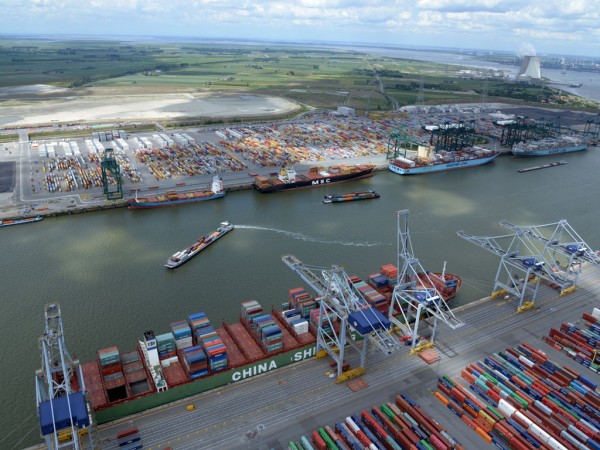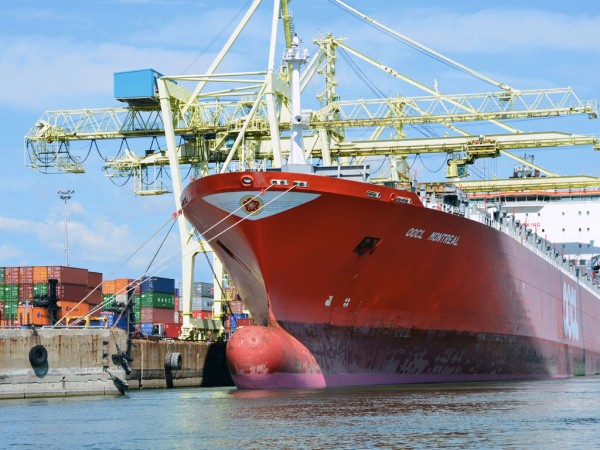While tariff issues with the U.S. are dominating the headlines, the Comprehensive Economic and Trade Agreement (CETA) between Canada and the EU has quietly eliminated 95% of all the tariffs on maritime trade.
This year has been marked by much turbulence on the global trade front in the wake of various protectionist initiatives by the Trump Administration. But there has been at least one major piece of good news – palpable benefits more rapidly than expected of the freshly-minted free trade agreement between Canada and the European Union (EU).

Implemented since September 21, 2017, the Comprehensive Economic and Trade Agreement (CETA) has yet to be ratified by all the states concerned. But well over 95% of all tariffs have disappeared and maritime trade across the Atlantic has clearly progressed.
Jack Mahoney, president of Maersk Line Canada, opined there is “strength in both directions” – an assessment supported by recent observations by the EU’s Commissioner for Trade, Cecilia Malmstrӧm.
“Confident even in the early days of CETA’s implementation that it would act like favorable wind in both directions, Maersk Line decided to add our own-operated string connecting Montreal and Halifax with the Mediterranean,” he recalled in an interview.

“Response to our “MMX” (Med / Montreal Express) has been positive,” Mahoney continued. “We know CETA is some part of that, and we believe that progress can also be attributed to Maersk Line’s offering Canadian exporters and importers another option to the Mediterranean, that it is one using Canadian ports rather than US ones, that we call Montreal as well as Halifax, that we use the well-regarded Cast terminal in Montreal (as we do for the north Europe, “CAE”), and that Maersk Line offers an increased ease of business with our online offering and expanded service staff presence in Canada.
“Also boosting the MMX’s performance is that the string calls Maersk facilities in the Mediterranean, allowing Maersk Line to connect from there to Africa, the Middle East, India and Pakistan, as well as Asia.”
Port of Montreal’s Big European Vacation
On Canada’s East Coast, the Port of Montreal is the leading player in the North Atlantic container trade, accounting for about 40% of its total box cargo of 1.5 million TEUs. The port remains on track for another record in 2018, with box throughput growth hovering in the high single digits as the year was drawing to a close, thanks in part to a dramatic increase in European containerized imports.
Tony Boemi, vice-president growth and development, indicated to the American Journal of Transportation: “We expect to hit 1.6 million TEUs in 2018 and are forecasting 1,675,000 TEUs in 2019.”
At the Maritime Employers Association (MEA) in Montreal, officials talk of a hiring spree for more dock workers.
Montreal terminal operators and other port employers have reportedly taken on more than 100 new workers in the past few months, chiefly in response to increased trade with Europe. MEA President Stephane Morency has noted this stems from expanded volumes of European products ranging from wine and cheese to steel girders. Canada’s trade with Asia via the Port of Montreal is also on the rise.
Considering the spike of containerized traffic related to CETA, the development of a new terminal at Contrecoeur, 25 miles downstream from Montreal on the St. Lawrence River, is “now more than ever a priority,” affirms Ryan Dermody, who was appointed last July to the newly-created post of Vice-President, Contrecoeur.
The new terminal would add more than one million TEUs to Montreal’s current container-handling capacity of 2.1 million TEUs. Valued at C$750 million, the project is still going through the assessment process with the Canadian Environmental Assessment Agency.
The promising outlook induced both Maersk Line and Hamburg-Sud to launch new services connecting Montreal to the Mediterranean. One in every five containers handled by the Port of Montreal comes from or goes to the Port of Antwerp, second largest in Northern Europe.
Trade with Europe also represents a traditional core business for the Port of Halifax, whose container cargo this past June represented the highest monthly volume in 10 years. The Nova Scotia port is on the comeback trail, with annual container cargo topping 500,000 TEUs as it profits from new services and deepened berths handling vessels with capacities above 10,000 TEUs.
“Although it is difficult to assess the full impact of CETA on trade between Canada and the European Union, the fact is that the numbers show an increase in both exports from and imports to this country,” declared Michael Broad, president of the Shipping Federation of Canada.
“The Port of Montreal, which handles some of our members’ ships trading between North Europe and the Mediterranean, saw record growth over the first seven months of the year, particularly in imports,” he said. “Although Canada’s export merchandise trade increased by 5%, some commodities and products, including aluminum and base metals saw substantial growth of between 40% and 150% since October 2017.
“Imports from the EU were up substantially – 11.5% - between October 2017 and May of this year. There could be many reasons for this increase in trade, including exchange rates and commodity prices, but we believe part of the increase is attributable to the CETA.”
Steel Prices & Volumes Up
Turning to the tariffs imposed by President Trump, Mr. Broad referred to developments that were ironically not totally negative.
“With respect to Trump’s tariffs, it is interesting to note that while steel from the EU has been hit with a 25% duty, volumes have not dropped at all and in fact we will probably see an increase in steel imports into the Great Lakes over last year. Interestingly, U.S. domestic steel producers have increased their prices by between 35% and 46% since the July 2017, so the tariffs seem to be having little effect on imports into the U.S.”
From Antwerp, Etienne De Vel, commercial manager, European Services and director, Fednav (Belgium) N.V. had similar views notably on steel product shipments: “President Trump’s decision to impose a 25 percent tax on all steel products being imported from Europe created some uncertainties on what this could have as an effect on the trade. Due to the strength of the local market in the US during the last three years, this decision has actually triggered the local mills in the US to increase their selling rates accordingly.”

According to freight forwarder Jeff Cullen, CEO of Rodair International, “CETA has yet to hit its stride and potential from our perspective. We have seen clients on the import side who have benefited from an improved lower landed cost base, but it has not yet driven any significant increase in volume.
“Our experience also has shown that it has been cumbersome and complicated for European exporters to comply with the requirements on country of origin (manufacture) versus country of shipment requirements. We are working with our clients and their suppliers to create the necessary level of compliance to create value. I feel long term CETA will be a strong opportunity for Canadian companies to diversify their trade risk from reliance on the USA as a primary partner, but it still early days.”
On a calendar year basis, Canadian merchandise exports to the 28 EU bloc rose from $40 billion in 2016 to $41.5 billion in 2017. Imports from the EU climbed to $108 billion from $100 billion.
The forward momentum has continued, as shown in a Global Affairs Canada estimate that Canadian exports to the EU were up 3.3% while imports surged 13% in the period between October 2017 and July 2018.
The EU country that exports the most to Canada is Germany ($18 billion), whose economy has outperformed the rest of Europe. The United Kingdom remains Canada’s biggest market in Europe but is losing ground amidst growing uncertainty pending a departure (Brexit) from the European common market. Latest figures show Canadian imports and exports from the UK on the decline while Canadian exports to and imports from Germany are both up 5%.
|
|





